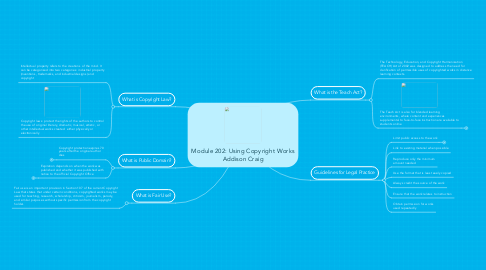Module 202: Using Copyright Works Addison Craig
by Addison Craig


1. What is Copyright Law?
1.1. Intellectual property refers to the creations of the mind. It can be categorized into two categories: industrial property (inventions, trademarks, and industrial designs) and copyright
1.2. Copyright laws: protect the rights of the authors to control the use of original literary, dramatic, musical, artistic, or other intellectual works created either physically or electronically
2. What is the Teach Act?
2.1. The Technology, Education, and Copyright Harmonization (TEACH) Act of 2002 was designed to address the need for clarification of permissible uses of copyrighted works in distance learning contexts.
2.2. The Teach Act is also for blended learning environments, where content and experiences supplemental to face-to-face instruction are available to students online
2.2.1. Included
2.2.2. Included
2.2.3. Excluded
3. What is Public Domain?
3.1. Copyright protection expires 70 years after the original author dies
3.1.1. Project specifications
3.1.2. End User requirements
3.1.3. Action points sign-off
3.2. Expiration depends on when the work was published and whether it was published with notice to the official Copyright Office
3.2.1. Define actions as necessary
4. What is Fair Use?
4.1. Fair use is an important provision in Section 107 of the current Copyright Law that states that under certain conditions, copyrighted works may be used for teaching, research, scholarship, criticism, journalism, parody, and similar purposes without specific permission from the copyright holder.
5. Guidelines for Legal Practice
5.1. Limit public access to the work
5.1.1. Materials
5.1.2. Personel
5.1.3. Services
5.1.4. Duration
